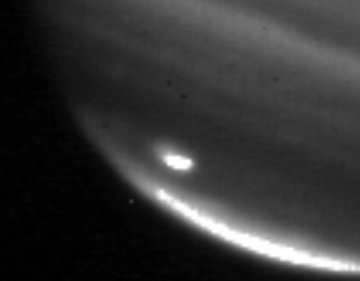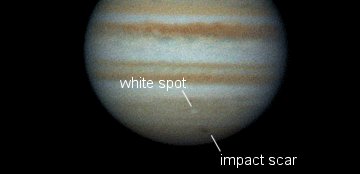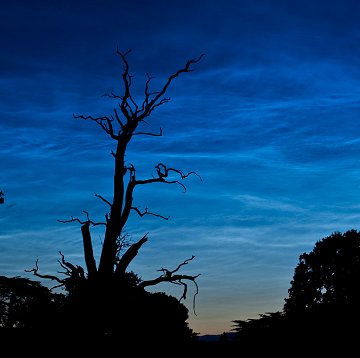Friday 31 July 2009
Next Shuttle Mission
July 29, 2009
MEDIA ADVISORY : M09-142
NASA Changes Date for Briefings on Next Space Shuttle Mission
HOUSTON -- A series of media briefings to preview NASA's STS-128 space shuttle mission has been rescheduled for Thursday, Aug. 13. NASA Television and the agency's Web site will provide live coverage of the mission briefings from NASA's Johnson Space Center in Houston beginning at 8 a.m. CDT. Questions will be taken from reporters at participating NASA centers and journalists in Europe. A feed of video and animation of the mission and crew training will precede the briefings at 7 a.m. U.S. reporters planning to attend the briefings in Houston must contact the Johnson newsroom at 281-483-5111 by 5 p.m., Aug. 6, for credentials. Journalists representing foreign news organizations, regardless of citizenship, must contact the Johnson newsroom by 5 p.m., July 30. Discovery's seven astronauts will be available for round-robin interviews at Johnson on Aug. 13. Reporters must contact Gayle Frere at 281-483-8645 by Aug. 6 to reserve an interview opportunity. For the latest information about the STS-128 mission and its crew, visit:
http://www.nasa.gov/shuttle
- end -
Thursday 30 July 2009
Gas Hooover Strike (impact On Jupiter)
Impact mark on Jupiter, 19th July 2009
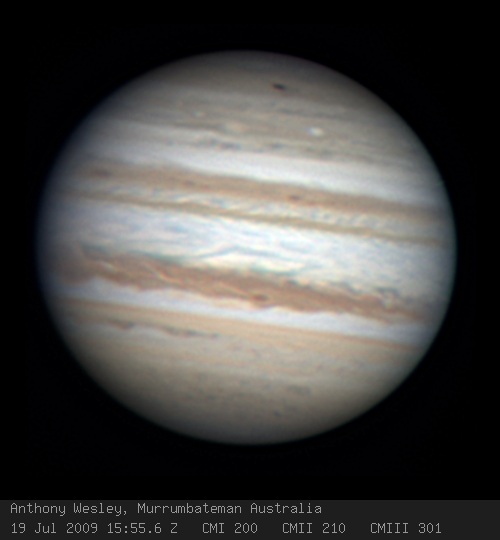
Image captured by Anthony Wesley on 19th July 2009 at 1554UTC from Murrumbateman Australia
I've been slashdotted, and my web server crushed. Now moved this to jupiter.samba.org provided by Tridge - thanks mate, you saved my a$$, you're a legend.
Preliminary image showing a black mark in Jupiters South Polar Region (SPR) which is almost certainly the result of a large impact - either an asteroid or comet - similar to the Shoemaker-Ley impacts in 1994.
Note to Media Images from this page may be used for editorial use only in news stories and publications provided correct attribution is retained.
Date and Time of Report
Dark impact mark first noted at approximately 1330UTC on 19th July 2009 from my home observatory just outside Murrumbateman NSW Australia.
Inspection of earlier images shows the impact visible on the planets limb at 1401UTC.
Equipment and Contact Details
Contact info: Anthony Wesley awesley@smartnetworks.com.au awesley@acquerra.com.au http://www.acquerra.com.au/astro Picture of Anthony and his 14.5 inch scope Scope: Homebrew GEM mounted Newtonian using a 14.5" Royce conical mirror (link to images removed until the slashdot tsumani retreats) Mount: Losmandy Titan Optics: - 14.5" f/5 Royce conical primary - 1/30 wave Antares Optics secondary - Televue 5x powermate , working at 7.7x Camera: Point Grey Research Dragonfly2 mono camera, ICX424al Filters: Astrodon I-Series RGB Capture details: 60 seconds in each filter @ 47fps. Capture software: Coriander Operating System: Linux (Fedora 10 x86) Processing software: Ninox for crop and presort Registax for alignment and stacking Astra Image for deconvolution and RGB align The Gimp for cleanup and captioning.
Observation Report
Update (20th July 1100UT) Glenn Orton from JPL has imaged this site using the NASA Infrared Telescope on Hawaii and confirms that it is an impact site and not a localised weather event.
I started this imaging session on Jupiter at approximately 11pm local time (1300UTC). The weather prediction was not promising, clear skies but a strong jetstream overhead according to the Bureau of Met. The temperature was also unusually high for this time of year (winter), also a bad sign.
The scope in use was my new 14.5" newtonian, in use now for a few weeks and so far returning excellent images.
I was pleasantly surprised to find reasonable imaging conditions and so I decided to continue recording data until maybe 1am local time. By about midnight (12:10 am) the seeing had deteriorated and I was ready to quit. Indeed I had hovered the mouse over the exit button on my capture application (Coriander for Linux) and then changed my mind and decided instead to simply take a break for 30 minutes and then check back to see if the conditions had improved. It was a very near thing.
When I came back to the scope at about 12:40am I noticed a dark spot rotating into view in Jupiters south polar region started to get curious. When first seen close to the limb (and in poor conditions) it was only a vaguely dark spot, I thouht likely to be just a normal dark polar storm. However as it rotated further into view, and the conditions improved I suddenly realised that it wasn't just dark, it was black in all channels, meaning it was truly a black spot.
My next thought was that it must be either a dark moon (like Callisto) or a moon shadow, but it was in the wrong place and the wrong size. Also I'd noticed it was moving too slow to be a moon or shadow. As far as I could see it was rotating in sync with a nearby white oval storm that I was very familiar with - this could only mean that the back feature was at the cloud level and not a projected shadow from a moon. I started to get excited.
It took another 15 minutes to really believe that I was seeing something new - I'd imaged that exact region only 2 days earlier and checking back to that image showed no sign of any anomalous black spot.
Now I was caught between a rock and a hard place - I wanted to keep imaging but also I was aware of the importance of alerting others to this possible new event. Could it actually be an impact mark on Jupiter? I had no real idea, and the odds on that happening were so small as to be laughable, but I was really struggling to see any other possibility given the location of the mark. If it really was an impact mark then I had to start telling people, and quickly. In the end I imaged for another 30 minutes only because the conditions were slowly improving and each capture was giving a slightly better image than the last.
Eventually I stopped imaging and went up to the house to start emailing people, with this image above processed as quick and dirty as possible just to have something to show.
More images will come along from me and many other people in the next few days.
*NOTE* Priority is being given to processing and uploading images as fast as possible, so the image quality is no necessarily as good as it might be. When time permits these images will be replaced by higher quality versions. Anthony
More Images:
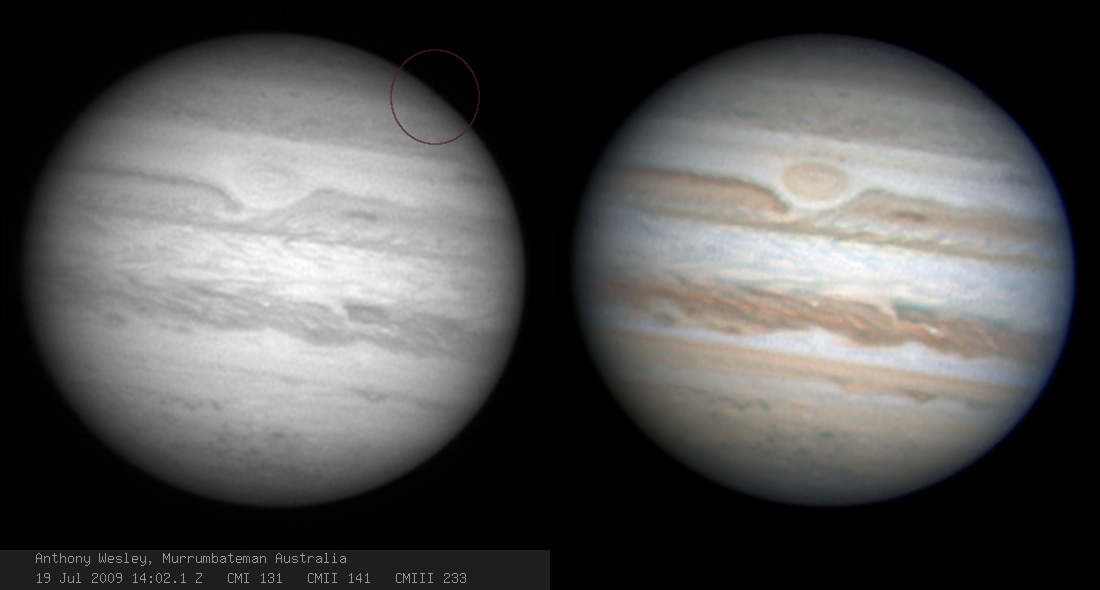
This is a very early image showing the impact mark (top right, on the limb). This image is red channel data only.
It is possible that this is the earliest recorded image of the event.
p.s. The GRS looks nice too, this was my real target for imaging this night!
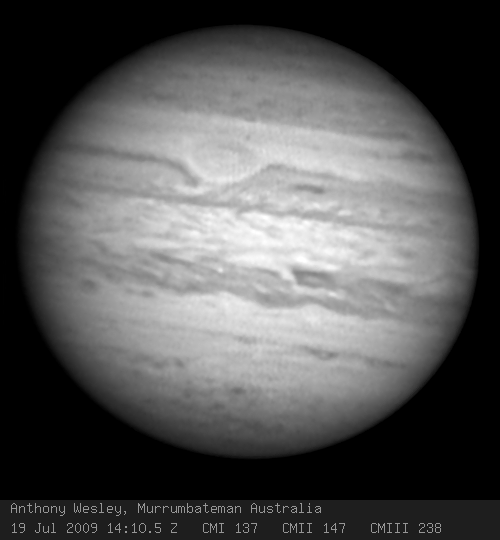
Another very early image of the dark spot, red channel data only. It's just visible on the limb to the upper right. Of course, it wasn't visible to me at the time I was recording the data, and after this sequence was captured I took a 30 minute break away from the scope... When I came back I noticed the dark spot.
Note the time on this image was incorrectly labelled as 141134UTC, this has been corrected
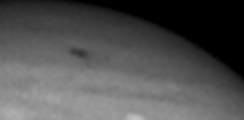
Closeup of this region in green light only, from reprocessed data (155537UTC). 3 small dark spots can be seen.
Update: Two of these three small spots may be pre-existing small storms. Thanks to a blink comparison by Brett Hughes.
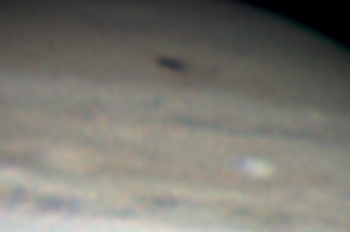
Same closeup as previous (155537UTC) , now in colour. 3 small dark spots can be seen in addition to the main one, possibly more. Still looking for better quality raw data from other imaging runs around this time.
Update: Two of these three small spots may be pre-existing small storms. Thanks to a blink comparison by Brett Hughes.
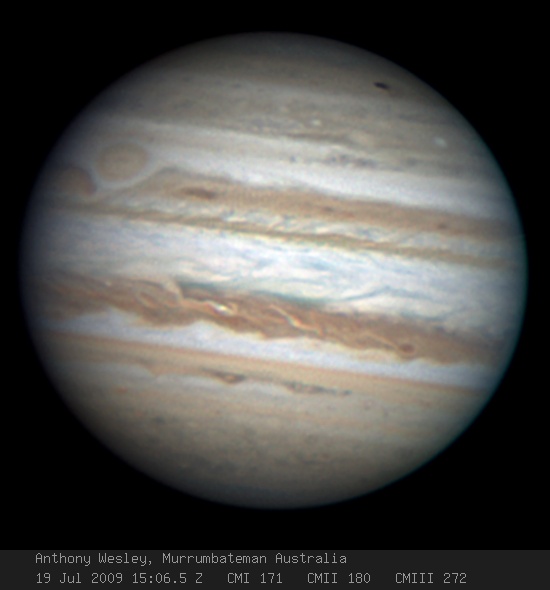
Earlier image showing the impact zone in slightly better seeing, but unfortunately the site itself is not as well resolved due to the viewing angle.

A later image in reasonable seeing.
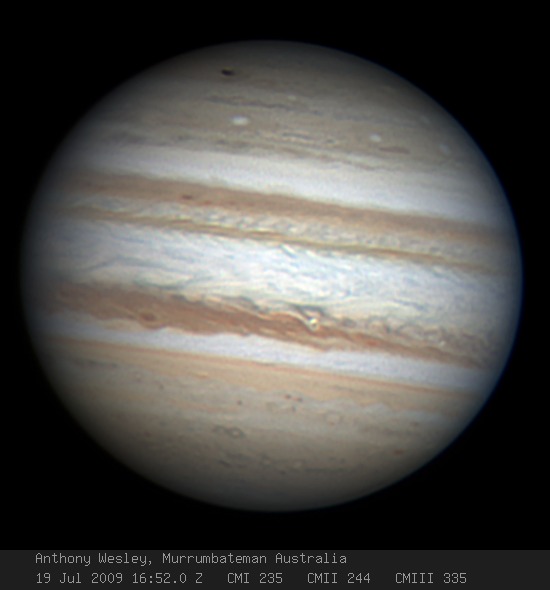
One of the last images from this session, this image has been more carefully processed to avoid artifacts by using 3x upsampling on the data before alignment and stacking.
23rd July 2009
Here are images from other amateurs from the first pass of this impact mark, on the same night as my images above. Please note that all images in this section are copyright to their respective owners and not for commercial use without their explicit explicit permission.
July 24 image

Here's an image in good seeing taken from my observatory on July 24, the impact region has started to spread noticeably.
Also see the Hubble Image taken shortly before this.
| |||
Mystery impact leaves Earth-size mark on Jupiter
(CNN) -- Jupiter is sporting a new scar after an unseen object hit the gaseous planet this week, NASA scientists say. An amateur astronomer in Australia noticed the new mark -- seen through telescopes as a dark spot -- on the planet early Monday and tipped off scientists at NASA's Jet Propulsion Laboratory (JPL) in Pasadena, California, who then confirmed it was the result of a new impact, NASA said. It's not clear what the object was that crashed into Jupiter's poisonous atmosphere. Glenn Orton, a JPL scientist, told the magazine New Scientist that it could have been a block of ice from somewhere in Jupiter's neighborhood, or a wandering comet that was too faint for astronomers to have detected before impact. The object created a mark on Jupiter that has the about same diameter as Earth, though the object itself was probably only 50 to 100 miles across, said Anthony Wesley, the amateur astronomer who first noticed the scar. The mystery object was likely moving at speeds of about 50 to 100 kilometers (31 to 62 miles) per second when it struck near Jupiter's south pole, Wesley told CNN. "That generates an unbelievable amount of energy when it collides with pretty much anything, but especially with something the size of Jupiter," he said. It is only the second time scientists have been able to observe the results of such an impact on Jupiter. The first happened 15 years ago, when comet Shoemaker-Levy 9 broke into 21 pieces and hit the planet's atmosphere. "Given the rarity of these events, it's extremely exciting to be involved in these observations," JPL astronomer Leigh Fletcher said in a NASA interview. Thermal images taken by NASA show the scar as a bright spot, which means the crash warmed the lower atmosphere in that area, New Scientist said. Researchers also found hints of higher-than-normal amounts of ammonia in the upper atmosphere. The Shoemaker-Levy comet also churned up extra ammonia, the magazine said. Jupiter's new spot isn't likely to last long -- probably just one to two weeks, Wesley said. He pointed out the impact scars from the Shoemaker-Levy debris lasted only two to three weeks before disappearing. Seeing an Earth-sized spot appear so tiny on Jupiter's surface led to some to wonder Tuesday whether our planet might be in danger of a similar collision. But Wesley said that shouldn't be a concern because Jupiter functions almost like a celestial vacuum cleaner, sucking up any objects that would be of danger to Earth and its neighbors. "Jupiter is doing a very good job in scooping up a lot of this material that's still floating around in the solar system," he said. "It's just got so much gravity as it swings around the outer part of the solar system, it can really pull in and swallow up many of the cometary objects and debris left over from the formation of the solar system. "So it's doing a good job in keeping us safe by cleaning out a lot of these bits and pieces." Jupiter is the fifth planet from the sun and the largest in our solar system. Its colorful atmosphere is 86 percent hydrogen and 14 percent helium, with tiny amounts of methane, ammonia, phosphine, water, acetylene, ethane, germanium, and carbon monoxide. The chemicals are responsible for producing the different colors of Jupiter's clouds. The temperature at the top of those clouds is about 230 degrees below zero Fahrenheit (145 degrees below zero Celsius), but it is far hotter near the planet's center. The core temperature may be about 43,000 degrees Fahrenheit (24,000 degrees Celsius), hotter than the surface of the sun. The most outstanding feature on Jupiter's surface is the Great Red Spot, a storm of gas that swirls at a speed of about 225 miles (360 kilometers) per hour at its edge. The spot -- which has been shrinking -- has a diameter equal to about three times that of Earth. |
| Find this article at: http://www.cnn.com/2009/TECH/space/07/21/jupiter.nasa.meteor.scar |
|
Harnessing the Sun
 This image, taken during the fifth and final spacewalk of the STS-127 mission, is of one of the International Space Station's solar panels intersecting Earth's horizon. Eleven astronauts and cosmonauts remained inside the orbital outpost and the shuttle to which it was docked, while Tom Marshburn and Christopher Cassidy made their spacewalk on July 24, 2009.Image Credit: NASA
This image, taken during the fifth and final spacewalk of the STS-127 mission, is of one of the International Space Station's solar panels intersecting Earth's horizon. Eleven astronauts and cosmonauts remained inside the orbital outpost and the shuttle to which it was docked, while Tom Marshburn and Christopher Cassidy made their spacewalk on July 24, 2009.Image Credit: NASA
An uncertain future for Sea Launch / Crew preps Endeavour for landing
---------------------------------------------------------------------
The latest news from Spaceflight Now
++++
SPACE SHUTTLE MISSION VIDEO!
Full coverage of Endeavour's flight
http://www.spaceflightnowplus.com/index.php?k=STS-127
++++
AN UNCERTAIN FUTURE FOR BANKRUPT SEA LAUNCH
-------------------------------------------
Already burdened by bankruptcy and a cutthroat rocket industry, Sea Launch
could face more defecting customers if the company does not soon assure
satellite operators of its future viability.
http://spaceflightnow.com/news/n0907/30sealaunch/
ASTRONAUTS PREP ENDEAVOUR FOR FRIDAY'S LANDING
----------------------------------------------
The Endeavour astronauts tested the shuttle's re-entry systems today
before packing up for the trip back to Earth Friday to close out a 16-day
space station assembly mission. There are no technical problems of any
significance, but forecasters are predicting a slight chance for rain and
thunderstorms near Endeavour's Florida runway at the 10:48 a.m. EDT
landing time.
http://spaceflightnow.com/shuttle/sts127/090730fd16/
STATION GETS NEW CARGO SHIP; SHUTTLE HEAT SHIELD CHECKED
--------------------------------------------------------
Space station commander Gennady Padalka aborted the automated approach of
an unmanned Russian Progress supply ship Wednesday after a problem of some
sort left it in the wrong orientation, taking over manual control and
remotely guiding the craft to a picture-perfect docking. The shuttle
astronauts, meanwhile, performed now-standard heat shield inspections to
look for space debris damage.
http://spaceflightnow.com/shuttle/sts127/090729fd15/
CONVERTED MISSILE ORBITS SIX SMALL SATELLITES
---------------------------------------------
Six small satellites were launched Wednesday aboard a Dnepr rocket,
delivering spacecraft into orbit for organizations in four countries. The
booster shot out of the underground silo in Kazakhstan at 1846 GMT.
http://spaceflightnow.com/news/n0907/29dnepr/
In Tandem

The Way Home
NASA's Shuttle Discovery Moves to Launch Pad, Practice Liftoff Set
Headquarters, Washington
202-358-1100
john.yembrick-1@nasa.gov
Candrea Thomas
Kennedy Space Center, Fla.
321-867-2468
candrea.k.thomas@nasa.gov
The first motion of Discovery from the Vehicle Assembly Building to Launch Pad 39A is scheduled for 12:01 a.m. EDT. The 3.4 mile journey is expected to take approximately six hours. Activities include a 6 a.m. photo opportunity of the shuttle's move and an interview availability with Discovery Flow Director Stephanie Stilson at 7 a.m. Reporters must arrive at Kennedy's news center by 5:30 a.m. Monday for transportation to the viewing area.
Live coverage of the move will be shown on NASA Television starting at 6 a.m. Video highlights of the move will air on NASA TV Video File.
International media accreditation for these events is closed. U.S. reporters without permanent Kennedy credentials must apply for accreditation online by 4 p.m. Thursday, July 30, at:
Badges must be picked up before 4 p.m. Friday, July 31, at the Kennedy Space Center Badging Office on State Road 405.
Discovery's astronauts and ground crews will participate in the practice countdown, known as the terminal countdown demonstration test. The test provides each shuttle crew with an opportunity to participate in various simulated countdown activities, including equipment familiarization and emergency training.
The following media events are associated with the test. All times are Eastern.
- Aug. 5 - STS-128 crew arrival. The astronauts will arrive at approximately 11:30 a.m. at the Shuttle Landing Facility and make a statement. The arrival will be broadcast live on NASA TV.
- Aug. 6 - STS-128 crew media availability. The crew will take questions from reporters at Launch Pad 39A at 8:40 a.m. The session will be carried live on NASA TV.
-Aug. 7 - STS-128 crew walkout photo opportunity. The astronauts will depart from the Operations and Checkout Building at 8:15 a.m. in their flight entry suits in preparation for the countdown demonstration test at the launch pad. The walkout will not be broadcast live, but will air on NASA TV Video File.
For information about covering these events, including proper attire and meeting locations, credentialed journalists should visit:
http://www.nasa.gov/centers/kennedy/news/media.html
Updates for all events are available at 321-867-2525.
For NASA TV downlink information, schedules and links to streaming video, visit:
For more information about the STS-128 mission and crew, visit:
- end -
Hubble Space Telescope Status Report
Engineers believe the anomaly is due to a potential flight software timing error that relates to the readout of the Multi-Anode Micro-channel Plate Array (MAMA) Interface Electronics RAM memory and developed a work around. The team safely resumed MAMA detector operations on July 28.
The Servicing Mission Observation Verification, or SMOV, activities this week involve verifying the Far Ultraviolet MAMA optical path, which will allow HST scientists to check the spectral resolution of the detectors prior to commencing science observations.
Space Shuttle Crew Set To Return To Earth Friday
Headquarters, Washington
202-358-1100
katherine.trinidad@nasa.gov
Candrea Thomas
Kennedy Space Center, Fla.
321-867-2468
candrea.k.thomas@nasa.gov
CAPE CANAVERAL, Fla. -- Space shuttle Endeavour and its seven-member crew are scheduled to return to Earth on Friday after a 16-day mission. There are two landing opportunities at NASA's Kennedy Space Center in Florida at 10:48 a.m. and 12:23 p.m. EDT.
NASA will evaluate weather conditions at Kennedy before permitting Endeavour and its crew to land. If weather prevents a return to Kennedy on Friday, the backup landing site at Edwards Air Force Base in California will be activated Saturday for consideration as well. For recorded updates about landing, call 321-867-2525.
Approximately two hours after landing, NASA officials will hold a media briefing to discuss the mission. The participants will be:
- Bill Gerstenmaier, associate administrator for the Space Operations Mission Directorate at NASA Headquarters in Washington
- Keiji Tachikawa, president, Japan Aerospace Exploration Agency
- Benoit Marcotte, director genenal, operations, Canadian Space Agency
- Mike Moses, space shuttle launch integration manager
- Pete Nickolenko, STS-127 launch director
After touchdown in Florida, the astronauts will undergo physical examinations and meet with their families. The crew is expected to hold a news conference at approximately 3:15 p.m. Both news events will be broadcast live on NASA Television and the agency's Web site.
The Kennedy news center will open for landing activities at 7 a.m. Friday and close at 7 p.m., or one hour after the last media event. STS-127 media badges are in effect through landing. The media accreditation building on State Road 3 will be open Friday from 7 a.m. to 9 a.m. The last bus will depart from the news center for the Shuttle Landing Facility one hour before landing.
If the landing is diverted to Edwards on Saturday, news media should call the Dryden public affairs office at 661-276-3449 for additional information. Dryden has limited facilities available for use by previously accredited journalists.
The NASA News Twitter feed is updated throughout the shuttle mission and landing. To access the feed, visit:
For NASA TV downlink information, schedules and links to streaming video, visit:
For the latest information about the STS-127 mission and accomplishments, visit:
- end -
Wednesday 29 July 2009
NASA to Provide Web Updates on Objects Approaching Earth
JET PROPULSION LABORATORY
CALIFORNIA INSTITUTE OF TECHNOLOGY
NATIONAL AERONAUTICS AND SPACE ADMINISTRATION
PASADENA, CALIF. 91109 TELEPHONE 818-354-5011
http://www.jpl.nasa.gov
DC Agle 818-393-9011
Jet Propulsion Laboratory, Pasadena, Calif.
agle@jpl.nasa.gov
INTERNET ADVISORY: 2009-115 July 29, 2009
NASA to Provide Web Updates on Objects Approaching Earth
PASADENA, Calif. -- NASA's Jet Propulsion Laboratory is introducing a new Web site
that will provide a centralized resource for information on near-Earth objects – those
asteroids and comets that can approach Earth. The "Asteroid Watch" site also contains
links for the interested public to sign up for NASA's new asteroid widget and Twitter
account.
"Most people have a fascination with near-Earth objects," said Don Yeomans, manager of
NASA's Near-Earth Object Program Office at JPL. "And I have to agree with them. I
have studied them for over three decades and I find them to be scientifically fascinating,
and a few are potentially hazardous to Earth. The goal of our Web site is to provide the
public with the most up-to-date and accurate information on these intriguing objects."
The new Asteroid Watch site is online at http://www.jpl.nasa.gov/asteroidwatch .
It provides information on NASA's missions to study comets, asteroids and near-Earth
objects, and also provides the basic facts and the very latest in science and research on
these objects. News about near-Earth object discoveries and Earth flybys will be available
and made accessible on the site via a downloadable widget and RSS feed. And for those
who want to learn about their space rocks on the go, a Twitter feed is offered. "Asteroid
Watch" also contains a link to JPL's more technical Near-Earth Objects Web site, where
many scientists and researchers studying near-Earth objects go for information.
"This innovative new Web application gives the public an unprecedented look at what's
going on in near-Earth space," said Lindley Johnson, program executive for the Near-
Earth Objects Observation program at NASA Headquarters in Washington.
NASA supports surveys that detect and track asteroids and comets passing close to Earth.
The Near-Earth Object Observation Program, commonly called "Spaceguard," also plots
the orbits of these objects to determine if any could be potentially hazardous to our planet.
JPL is a division of the California Institute of Technology in Pasadena.
-end-
Tuesday 28 July 2009
 Another View
Another ViewSeen in the mirrored helmet visor of astronaut Christopher Cassidy is astronaut Tom Marshburn on the STS-127 mission's fourth spacewalk. The two teamed up again on July 27 for the STS-127 crew's fifth and final spacewalk. Eleven astronauts and cosmonauts remained inside the International Space Station and the shuttle to which it was docked, while the two suited astronauts continued work on the orbital outpost.
Monday 27 July 2009
Japenese Experiment Module - Exposed Facility
 This image shows the Japanese Experiment Module - Exposed Facility as it looks from inside Kibo. The Japanese Experiment Module, or JEM, called Kibo -- which means "hope" in Japanese -- is Japan's first human space facility and enhances the unique research capabilities of the International Space Station. Experiments in Kibo focus on space medicine, biology, Earth observations, material production, biotechnology and communications research. Kibo experiments and systems are operated from the Mission Control Room at the Space Station Operations Facility, or SSOF, at Tsukuba Space Center in Ibaraki Prefecture, Japan, just north of Tokyo.
This image shows the Japanese Experiment Module - Exposed Facility as it looks from inside Kibo. The Japanese Experiment Module, or JEM, called Kibo -- which means "hope" in Japanese -- is Japan's first human space facility and enhances the unique research capabilities of the International Space Station. Experiments in Kibo focus on space medicine, biology, Earth observations, material production, biotechnology and communications research. Kibo experiments and systems are operated from the Mission Control Room at the Space Station Operations Facility, or SSOF, at Tsukuba Space Center in Ibaraki Prefecture, Japan, just north of Tokyo.Image Credit: NASA
Endeavour crew completes mission's fifth and final spacewalk
---------------------------------------------------------------------
The latest news from Spaceflight Now
===========================================
Looking for a job out of this world?
The top jobs and the best talents in
the space industry are on Space Careers.
http://www.space-careers.com/?id=sfn
Space Careers, a one-stop reference source
for employment in the space industry.
===========================================
ENDEAVOUR CREW COMPLETES MISSION'S FIFTH AND FINAL SPACEWALK
------------------------------------------------------------
Astronauts Chris Cassidy and Tom Marshburn went outside the International
Space Station for a five-hour spacewalk today to install two Japanese
television cameras on the new Exposed Facility, re-wire the power to two
of the station's stabilizing gyroscopes, fix insulation on a Canadian
robot and accomplish other minor get-ahead tasks. It was the last in a
series of five EVAs for shuttle Endeavour's mission.
http://spaceflightnow.com/shuttle/sts127/status.html
STATION'S CARBON DIOXIDE SCRUBBER BACK ON LINE
----------------------------------------------
Worried the shuttle Endeavour might have to undock early because of a
carbon dioxide removal problem aboard the International Space Station,
engineers at the Johnson Space Center in Houston came up with a manual
control work-around that successfully restored the CO2 removal system to
near-normal operation.
http://spaceflightnow.com/shuttle/sts127/090726fd12/
CREW PLEASED WITH MISSION PROGRESS:
http://spaceflightnow.com/shuttle/sts127/090726fd12/index2.html
SHUTTLE DISCOVERY MOVES TO VEHICLE ASSEMBLY BUILDING
----------------------------------------------------
While shuttle Endeavour orbits the Earth at the International Space
Station, sister-ship Discovery moved from its hangar to the Vehicle
Assembly Building at the Kennedy Space Center on Sunday morning in
preparation for launch to the outpost in late August.
http://spaceflightnow.com/shuttle/sts128/status.html
JPL OPTIMISTIC ABOUT FREEING SPIRIT AS ROVER TESTS REFINED
----------------------------------------------------------
Mars rover engineers hope to start maneuvering Spirit out of its sand trap
about in early August, after conducting a second series of tests with a
ground test rover at the Jet Propulsion Laboratory.
http://spaceflightnow.com/news/n0907/25spirit/
Friday 24 July 2009
The Impact on Jupiter





by The Editors of Sky & Telescope
Anthony WesleyThe image at right, taken by Anthony Wesley, a well-known Australian astrophotographer and planetary observer, shows a new dark marking on Jupiter strikingly similar to the ones left when Comet Shoemaker-Levy 9 crashed into the giant planet in 1994. The dark mark, which appeared suddenly between July 17th and 19th, was quickly confirmed by many other observers. Amateurs have been spotting it in 4-inch and smaller telescopes, at least when Jupiter is high after midnight and the atmospheric seeing steadies up. Wesley has put up a Jupiter impact page with more of his own images.
"Here is the spot recorded this morning in marginal seeing," writes S&T's Sean Walker. "It appears to me to be spreading out as predicted." The shot was made with a 14.5-inch reflector and stacked video at 3:46 UT July 21, 2009.
More amateur photos are posted at the Spaceweather.com pages for July 21 and July 24.
The Jet Propulsion Lab quickly put out a news release with near-infrared (reflected-light) images (also available here if the first site is overloaded.)
Here's a local article from Australia on Anthony Wesley and his discovery.
The Hubble Space Telescope team suspended their shakedown and calibration of the recently rebuilt telescope and rushed its new Wide Field Camera 3 into service to image the impact mark. And what a success! The image below resolves far more detail in the mark than any imagery yet from the ground, and will surely tell more about the impact itself. Read all about it, and view more Hubble images.
Hubble's new Wide Field Camera 3 was rushed into service to take this closeup of Jupiter's impact mark on July 23, 2009. In this view north is up.
NASA / ESA / Heidi Hammel / Jupiter Impact Team
Grueling spacewalk underway / Hubble to look at Jupiter's scar / Shuttle delay
---------------------------------------------------------------------
The latest news from Spaceflight Now
++++
SPACE SHUTTLE MISSION VIDEO!
Full coverage of Endeavour's flight
http://www.spaceflightnowplus.com/index.php?k=STS-127
++++
STATION TO GET MORE FRESH BATTERIES DURING SPACEWALK
----------------------------------------------------
What's expected to be a grueling spacewalk lasting perhaps
seven-and-a-half hours today, Endeavour astronauts Chris Cassidy and Tom
Marshburn plan to finish the job started Wednesday of replacing batteries
in the International Space Station's oldest power module.
http://spaceflightnow.com/shuttle/sts127/status.html
SPACE STATION RESUPPLY SHIP BLASTS OFF
--------------------------------------
An unmanned resupply ship for the International Space Station was
successfully launched into orbit today, headed for a docking next week
after the space shuttle Endeavour leaves the outpost.
http://spaceflightnow.com/news/n0907/24progress34p/
HUBBLE TAKES UNPLANNED GLANCE AT JUPITER'S SCAR
-----------------------------------------------
Taking a break from extensive testing following May's shuttle repair
mission, the Hubble Space Telescope was expected to point toward Jupiter
Thursday to take pictures of a dark impact scar that first appeared on the
giant planet last weekend.
http://spaceflightnow.com/news/n0907/24hubble/
SERVICING MISSION ARCHIVE:
http://spaceflightnow.com/shuttle/sts125/
CHANDRA TELESCOPE MARKS A DECADE OF X-RAY ASTRONOMY
---------------------------------------------------
Astronomers celebrated the 10th birthday of the Chandra X-ray Observatory
on Thursday, a decade after the shuttle Columbia sent the hefty telescope
to a looping orbit high above Earth.
http://spaceflightnow.com/news/n0907/23chandra/
MORE FUEL TANK TESTS WILL DELAY NEXT SHUTTLE LAUNCH
---------------------------------------------------
NASA managers decided Thursday to order another 125 foam "plug-pull" tests
on the external tank scheduled for use by the shuttle Discovery next month
to make sure there are no adhesion problems like those that resulted in
unusual foam shedding during Endeavour's takeoff last week.
http://spaceflightnow.com/shuttle/sts127/090723sts128tank/
STATION'S OUTDOOR SCIENCE DECK GETS ITS FIRST PAYLOADS
------------------------------------------------------
Aboard the International Space Station on Thursday, the astronauts used
Japan's robot arm to mount an X-ray astronomy experiment, a communications
relay package and a space environment monitor onto the new external
science facility.
http://spaceflightnow.com/shuttle/sts127/090723fd9/index2.html
CIRQUE DU SOLEIL FOUNDER EAGER TO VISIT SPACE STATION
-----------------------------------------------------
Guy Laliberte, a former street entertainer who founded the enormously
successful Cirque du Soleil, says he doesn't plan any fire eating or stilt
walking aboard the International Space Station when he visits this fall.
http://spaceflightnow.com/station/exp21/090723crew.html
Apollo 11 Comes Home
 The Apollo 11 crew await pickup by a helicopter from the USS Hornet, prime recovery ship for the historic lunar landing mission. The fourth man in the life raft is a United States Navy underwater demolition team swimmer. All four men are wearing biological isolation garments.The Apollo 11 Command Module Columbia with astronauts Neil Armstrong, Michael Collins, and Buzz Aldrin aboard splashed down at 11:49 a.m. CDT, July 24, 1969, about 812 nautical miles southwest of Hawaii and only 12 nautical miles from the USS Hornet. Image Credit: NASA
The Apollo 11 crew await pickup by a helicopter from the USS Hornet, prime recovery ship for the historic lunar landing mission. The fourth man in the life raft is a United States Navy underwater demolition team swimmer. All four men are wearing biological isolation garments.The Apollo 11 Command Module Columbia with astronauts Neil Armstrong, Michael Collins, and Buzz Aldrin aboard splashed down at 11:49 a.m. CDT, July 24, 1969, about 812 nautical miles southwest of Hawaii and only 12 nautical miles from the USS Hornet. Image Credit: NASA
Giants Among Us
 Apollo 11 astronauts, from left, Michael Collins, Neil Armstrong and Buzz Aldrin stand in recognition of astronaut John Glenn during the U.S House of Representatives Committee on Science and Technology tribute to the Apollo 11 astronauts at the Cannon House Office Building on Capitol Hill, Tuesday, July 21, 2009, in Washington. The committee presented the three Apollo 11 astronauts with a framed copy of House Resolution 607 honoring their achievement, and announced passage of legislation awarding them and John Glenn the Congressional Gold Medal. Image Credit: NASA/Bill Ingalls
Apollo 11 astronauts, from left, Michael Collins, Neil Armstrong and Buzz Aldrin stand in recognition of astronaut John Glenn during the U.S House of Representatives Committee on Science and Technology tribute to the Apollo 11 astronauts at the Cannon House Office Building on Capitol Hill, Tuesday, July 21, 2009, in Washington. The committee presented the three Apollo 11 astronauts with a framed copy of House Resolution 607 honoring their achievement, and announced passage of legislation awarding them and John Glenn the Congressional Gold Medal. Image Credit: NASA/Bill Ingalls
Hubble Space Telescope Captures Rare Jupiter Collision
 This Hubble picture, taken on July 23, by the new Wide Field Camera 3, is the sharpest visible-light picture taken of the atmospheric debris from a comet or asteroid that collided with Jupiter on July 19. This is Hubble's first science observation following its repair and upgrade in May. The size of the impactor is estimated to be as large as several football fields.
This Hubble picture, taken on July 23, by the new Wide Field Camera 3, is the sharpest visible-light picture taken of the atmospheric debris from a comet or asteroid that collided with Jupiter on July 19. This is Hubble's first science observation following its repair and upgrade in May. The size of the impactor is estimated to be as large as several football fields.Image Credit: NASA, ESA, and H. Hammel (Space Science Institute, Boulder, Colo.), and the Jupiter Impact Team
View Larger Image
NASA's Hubble Space Telescope has taken the sharpest visible-light picture yet of atmospheric debris from an object that collided with Jupiter on July 19. NASA scientists decided to interrupt the recently refurbished observatory's checkout and calibration to take the image of a new, expanding spot on the giant planet on July 23.
Discovered by Australian amateur astronomer Anthony Wesley, the spot was created when a small comet or asteroid plunged into Jupiter's atmosphere and disintegrated. The only other time such a feature has been seen on Jupiter was 15 years ago after the collision of fragments from comet Shoemaker-Levy 9.
"Because we believe this magnitude of impact is rare, we are very fortunate to see it with Hubble," said Amy Simon-Miller of NASA's Goddard Space Flight Center in Greenbelt, Md. "Details seen in the Hubble view shows a lumpiness to the debris plume caused by turbulence in Jupiter's atmosphere."
The new Hubble images also confirm that a May servicing visit by space shuttle astronauts was a big success.
"This image of the impact on Jupiter is fantastic," said U.S. Sen. Barbara A. Mikulski, D-Md., chairwoman of the Commerce, Justice and Science Appropriations Subcommittee. "It tells us that our astronauts and the ground crew at the Goddard Space Flight Center successfully repaired the Hubble telescope. I'm so proud of them and I can't wait to see what's next from Hubble."
For the past several days, Earth-based telescopes have been trained on Jupiter. To capture the unfolding drama 360 million miles away, Matt Mountain, director of the Space Telescope Science Institute in Baltimore, gave observation time to a team of astronomers led by Heidi Hammel of the Space Science Institute in Boulder, Colo.
"Hubble's truly exquisite imaging capability has revealed an astonishing wealth of detail in the impact site," Hammel said. "By combining these images with our ground-based data at other wavelengths, our Hubble data will allow a comprehensive understanding of exactly what is happening to the impact debris."
Simon-Miller estimated the diameter of the impacting object was the size of several football fields. The force of the explosion on Jupiter was thousands of times more powerful than the suspected comet or asteroid that exploded over the Siberian Tunguska River Valley in June 1908.
The image was taken with the Wide Field Camera 3. The new camera, installed by the astronauts aboard space shuttle Atlantis in May, is not yet fully calibrated. While it is possible to obtain celestial images, the camera's full power has yet to be seen.
"This is just one example of what Hubble's new, state-of-the-art camera can do, thanks to the STS-125 astronauts and the entire Hubble team," said Ed Weiler, associate administrator of NASA's Science Mission Directorate in Washington. "However, the best is yet to come."
Thursday 23 July 2009
At Work In Space
 Astronaut Tom Marshburn performs his first spacewalk and the STS-127 crew's second of the five scheduled to continue work on the International Space Station. Astronauts Marshburn and Dave Wolf (out of frame) successfully transferred a spare KU-band antenna to long-term storage on the space station, along with a backup coolant system pump module and a spare drive motor for the station's robot arm transporter. Image Credit: NASA
Astronaut Tom Marshburn performs his first spacewalk and the STS-127 crew's second of the five scheduled to continue work on the International Space Station. Astronauts Marshburn and Dave Wolf (out of frame) successfully transferred a spare KU-band antenna to long-term storage on the space station, along with a backup coolant system pump module and a spare drive motor for the station's robot arm transporter. Image Credit: NASA
Interview with NASA's new leader / Live coverage of today's spacewalk
---------------------------------------------------------------------
The latest news from Spaceflight Now
++++
Apollo Commemorative Patches
http://www.spaceflightnowstore.com
++++
NASA'S NEW LEADER OPTIMISTIC ABOUT REVIEWS
------------------------------------------
New NASA Administrator Charles Bolden, a respected former shuttle
commander and retired Marine Corp major general, said Tuesday he's
confident an on-going presidential review of NASA's manned space program
will not result in changes that would lengthen the projected five-year gap
between the end of shuttle operations and the debut of a new rocket system
to replace it.
http://spaceflightnow.com/news/n0907/21nasa/
CREW TO SWAP OUT BATTERIES IN SPACE STATION'S POWER GRID
--------------------------------------------------------
Astronauts Dave Wolf and Chris Cassidy have begun today's challenging
spacewalk to replace four aging batteries in the International Space
Station's oldest solar array power module on the far left end of the
complex's truss backbone. Follow the EVA with live updates and streaming
video in our Mission Status Center:
http://spaceflightnow.com/shuttle/sts127/status.html
RELIVE ENDEAVOUR'S LAUNCH WITH ROCKET BOOSTER CAMERAS
-----------------------------------------------------
Onboard rocket camera footage always dazzles and the video from shuttle
Endeavour's solid boosters doesn't disappoint. The inspiring views of the
spacecraft rocketing toward orbit are presented here for Spaceflight
Now+Plus users with launch audio.
http://spaceflightnowplus.com/index.php?k=STS-127
+++
GET OUR LIVE UPDATES FROM TWITTER!
Sign up to Spaceflight Now's Twitter feed
and get text message updates on your cell phone.
http://twitter.com/spaceflightnow/
+++
Servicing Mission Observatory Verification (SMOV) Update
- Hubble is now functioning with three of its six new gyroscopes. As planned, the other three have been turned off to keep in reserve.
- Hubble's new batteries are performing as expected, with more charging capacity than the ones they replaced.
- The new thermal panels are functioning as anticipated, keeping equipment Bays 5, 7, and 8 at their expected temperatures.
Testing and calibration continues on the science components.
- The Science Instrument Command and Data Handling Unit (SIC&DH) has been turned on again after its June electronic malfunction, and is functioning normally. The problem has not reoccurred. Engineers continue to monitor the SIC&DH.
- All instruments contain a number of channels, which detect and processes different wavelengths. Wide Field Camera 3 is now aligned and focused in both of its channels, and is undergoing calibration.
- Scientists and engineers have nearly finished aligning the Cosmic Origins Spectrograph (COS). When an instrument enters space, weightlessness can cause it to go out of alignment. Engineers adjust the instrument from the ground, controlling tiny mirrors inside the instrument. One channel is fully aligned, and the other's alignment should be completed over the next few days. COS's other planned calibrations, typically involving internal measurements of the instrument, are going well. The COS far-UV channel successfully conducted its first external observation this week in preparation for the alignment process.
- The Space Telescope Imaging Spectrograph has been suspended due to a memory anomaly. Engineers are working on the problem.
- The Advanced Camera for Surveys (ACS) has completed all testing, alignment and calibration activities and is taking science observations. Two of the instrument's channels — one seeing ultraviolet light, the other visible light — are functioning very well. The third, a high-resolution channel that, for example, takes pictures of the central regions of galaxies, could not be restored during the servicing mission. This channel was thought to have a 50-50 chance of being brought back online, so the result is not unexpected. The return of the visible light channel, responsible for many of ACS's famous images, is a particular triumph.
Baltimore, MD
Aurora Surprise
http://spaceweather.com
AURORA SURPRISE: Last night, July 21st and 22nd, a solar wind stream hit Earth's magnetic field and surprised observers with an unexpected display of auroras. Northern Lights swept across parts of Canada and descended as far south as the Dakotas, Montana, Iowa and Wisconsin in the United States. Photos of the display are featured on today's edition of http://spaceweather.com .
AURORA ALERTS: Did you sleep through the show? Next time get a wake up call from Space Weather PHONE: http://spaceweatherphone.com.
JULY 22nd SOLAR ECLIPSE GALLERY: The longest solar eclipse of the 21st century is over and, despite a disappointing rainstorm over Shanghai, millions of people witnessed the event. Highlights may be found in our eclipse gallery. Start browsing here: http://spaceweather.com/eclipses/gallery_22jul09_page3.htm
Tuesday 21 July 2009
Tests on Earth to Help Free Spirit Rover on Mars: Live Webcast, Chat
JET PROPULSION LABORATORY
CALIFORNIA INSTITUTE OF TECHNOLOGY
NATIONAL AERONAUTICS AND SPACE ADMINISTRATION
PASADENA, CALIF. 91109 TELEPHONE 818-354-5011
http://www.jpl.nasa.gov
Guy Webster/Carolina Martinez 818-354-6278/354-9382
Jet Propulsion Laboratory, Pasadena, Calif.
guy.webster@jpl.nasa.gov / carolina.martinez@jpl.nasa.gov
INTERNET ADVISORY: 2009-113 July 21, 2009
Tests on Earth to Help Free Spirit Rover on Mars: Live Webcast, Chat
The team that operates rovers on Mars is using a test rover in southern California to assess
maneuvers the Mars rover Spirit might use to get out of soft, loose soil where its wheels have sunk
hub-deep. A live videocast and chat from NASA's Jet Propulsion Laboratory, Pasadena, Calif.,
will give viewers a chance to ask questions of rover team members working to get Spirit rolling
again.
The live event will air on the "NASAJPL" channel available on Ustream Web TV at:
http://www.ustream.tv/channel/nasajpl on Thursday, July 23, beginning at 3 p.m. PDT (6 p.m. EDT
and 2200 UTC).
Spirit and its twin, Opportunity, landed on Mars in January 2004 for what were planned as three-
month missions to study sites on opposite sides of the planet. Both are still active and returning
streams of scientific information. Spirit has not driven since May 6, 2009, when it had become
partially embedded in the soil. To minimize the risk of worsening Spirit's predicament, operators
decided to conduct a series of experiments with a test rover before driving Spirit again.
Participants in the July 23 event include:
* John Callas, project manager for NASA's Mars Exploration Rovers, Spirit and Opportunity.
* Ashley Stroupe, JPL rover planner, deputy lead for "Free Spirit" testing
Viewers may submit questions over Ustream or via Twitter. Twitter users may send their questions
to @NASAJPL using the hashtag #FreeSpirit. In addition, if you are unable to take part in the live
chat, you may submit questions in advance to chatquestion@jpl.nasa.gov and watch the archived
video at a later time.
Information about Spirit and Opportunity is available at http://www.nasa.gov/rovers . Updates
about testing of possible maneuvers for freeing Spirit are at http://www.jpl.nasa.gov/freespirit .
JPL is managed for NASA by the California Institute of Technology, Pasadena.
-end-
Work Continues On The Station
 In this one of a series of digital still images, astronaut Dave Wolf performs his second spacewalk, which is also the second of five scheduled spacewalks for the STS-127 mission. Astronauts Wolf and Tom Marshburn (out of frame) successfully transferred a spare KU-band antenna to long-term storage on the space station, along with a backup coolant system pump module and a spare drive motor for the station's robot arm transporter. Installation of a television camera on the Japanese Exposed Facility experiment platform was deferred to a later spacewalk.Image Credit: NASA
In this one of a series of digital still images, astronaut Dave Wolf performs his second spacewalk, which is also the second of five scheduled spacewalks for the STS-127 mission. Astronauts Wolf and Tom Marshburn (out of frame) successfully transferred a spare KU-band antenna to long-term storage on the space station, along with a backup coolant system pump module and a spare drive motor for the station's robot arm transporter. Installation of a television camera on the Japanese Exposed Facility experiment platform was deferred to a later spacewalk.Image Credit: NASA
Total Solar Eclipse--Full Coverage
http://spaceweather.com
SOLAR ECLIPSE: The longest total eclipse of the 21st century is about to begin. It starts just hours from now at approximately 9 p.m. EDT on July 21st (0100 UT on July 22nd). The path of totality crosses many major cities in India and China, setting the stage for possibly the best-observed eclipse in history. Photos from the path of totality will be posted on http://spaceweather.com as the event unfolds.
COSMIC COLLISION: Evidence is mounting that something did hit Jupiter no more than a few days ago. The impact site (a dark "scar" in Jupiter's clouds) was discovered on July 19th by Australian amateur astronomer Anthony Wesley, and NASA astronomers quickly confirmed the find. Infrared photos posted on today's edition of Spaceweather.com are consistent with an asteroid or comet strike on the giant planet. The debris zone in Jupiter's clouds is itself as wide as a small planet, making it an easy target for backyard telescopes.
SPACE WEATHER ALERTS: For less than the cost of a night at the movies, you can get real time space weather alerts on your cell phone and never miss another big solar flare or geomagnetic storm. Sign up for Space Weather PHONE: http://spaceweatherphone.com .
What's up in Space
| July 21, 2009 | ||||||
SOLAR ECLIPSE: The longest solar eclipse of the 21st century takes place this Wednesday, July 22nd. The path of totality crosses many major cities, setting the stage for possibly the best-observed eclipse in human history. Get the full story from Science@NASA. COSMIC COLLISION: Evidence is mounting that something hit Jupiter no more than a few days ago. The impact site was discovered by amateur astronomer Anthony Wesley on July 19th. Using a 14.5-inch telescope at his backyard observatory in Murrumbateman, Australia, he photographed a dark scar in Jupiter's clouds. NASA astronomers rushed to confirm the find, and with this photo from the Infrared Telescope Facility in Hawaii, they did: The bright spot is near-infrared sunlight reflected from particulate matter floating through the top of Jupiter's atmosphere. These particulates are likely debris from something that hit the planet and exploded. "This has all the hallmarks of the comet Shoemaker-Levy 9 impacts of 1994," says Leigh Fletcher of JPL who gathered the infrared data along with colleague Glenn Orton. If the impact hypothesis is indeed correct, the "scar" should become spread out by jet streams in the days ahead. Amateur astronomers can monitor events using mid-sized backyard telescopes: sky map. The spot is located near Jupiter's System II longitude 210°. For the predicted times when it will cross the planet's central meridian, add 2 hours and 6 minutes to Sky and Telescope's predicted transit times for Jupiter's Great Red Spot. UPDATE: On July 20th, Dennis Simmons of Brisbane Australia recorded a 75-minute movie of the impact site. Click on the image to launch a gif animation: "It is quite fascinating to observe the white spot (a Mars-sized storm) appearing to overtake the impact scar," notes Simmons. "To make the movie I used a 7-inch Takahashi Mewlon 180 telescope with a Vixen x2 Barlow and a DBK21AF04 ccd camera." more images: from Antonello Medugno of Italy; from Robert Lunsford of Chula Vista, California; from Jeremy Perez of Flagstaff, Arizona; from Theo Ramakers of Social Circle, Georgia; from Anthony Wesley of Murrumbateman, Australia; from Ian Sharp of Ham, West Sussex, England, UK; from David Kolb of Lawrence, Kansas; from David Storey of Isle of Man, Great Britain; from Frank Ryan Jr of Shannon, Ireland; from Russell Hawker of Eastleigh, Hampshire; from Lars Zielke of Tvis, Denmark; NOCTILUCENT CLOUDS: Noctilucent clouds are brightening again over Europe. "On July 20th we had a fantastic display--possibly the best of the year so far," reports John Houghton of Leicester UK. He snapped this photo using a Nikon D700: The display was vivid electric-blue and included some unusual forms. "They reminded me of a great whale swimming across the sky," remarks eyewitness Peter Vasey of Hexham UK. When a similar display materialized over Europe last week, the clouds quicky spread across the Atlantic, appearing in the USA as far south as Utah, Colorado, northern California and Nevada. Could it happen again tonight? Browse the photo gallery for observing tips: UPDATED: 2009 Noctilucent Photo Gallery | ||||||
The Beauty Of Space
 Astronaut Tim Kopra worked to prepare the berthing mechanisms on the Kibo laboratory and the Japanese Exposed Facility (JEF) for the JEF installation on Kibo, during this the first of five planned spacewalks for the STS-127 crew. Kopra, who was joined astronaut Dave Wolf (out of frame) on this spacewalk, holds onto a handrail on Harmony node. When the Endeavour crew returns to Earth, Kopra will stay aboard the station to serve as a flight engineer.Image Credit: NASA
Astronaut Tim Kopra worked to prepare the berthing mechanisms on the Kibo laboratory and the Japanese Exposed Facility (JEF) for the JEF installation on Kibo, during this the first of five planned spacewalks for the STS-127 crew. Kopra, who was joined astronaut Dave Wolf (out of frame) on this spacewalk, holds onto a handrail on Harmony node. When the Endeavour crew returns to Earth, Kopra will stay aboard the station to serve as a flight engineer.Image Credit: NASA
Something has struck Jupiter / Armstrong marks anniversary in own words
---------------------------------------------------------------------
The latest news from Spaceflight Now
+++
SEE ENDEAVOUR'S LAUNCH IN HI-DEF!
Spaceflight Now Plus subscribers can watch stunning footage of Endeavour's
launch
Watch on your big screen TV with Apple TV, Xbox-360 or PS3
http://www.spaceflightnowplus.com/hd/sts127/
+++
PICTURES REVEAL SOMETHING HAS STRUCK JUPITER
--------------------------------------------
Following up on a tip by an amateur astronomer that a new dark "scar" had
suddenly appeared on Jupiter, scientists have found evidence that another
object has indeed bombarded the planet, exactly 15 years after the first
impacts by the comet Shoemaker-Levy 9.
http://spaceflightnow.com/news/n0907/20jupiter/
ASTRONAUT ARMSTRONG MARKS ANNIVERSARY IN OWN WORDS
--------------------------------------------------
The first man on the moon took a moment Monday, on the 40th anniversary of
his "giant leap," to remember the Apollo program and the engineering
triumph that won the Cold War space race and opened the door to the manned
exploration of the solar system.
http://spaceflightnow.com/news/n0907/20armstrong/
A PAIR OF RUSSIAN SPACECRAFT LAUNCHED BY SMALL ROCKET
-----------------------------------------------------
A Kosmos 3M rocket boosted a secret Russian military satellite and a
civilian search and rescue spacecraft into orbit early Tuesday from the
Plesetsk Cosmodrome.
http://spaceflightnow.com/news/n0907/21kosmos3m/
JAPANESE EXPERIMENTS REMOVED FROM THE SHUTTLE
---------------------------------------------
The Endeavour astronauts spent the morning working with the shuttle and
station robot arms, pulling a pallet of Japanese experiments from the
orbiter's payload bay and moving it into position for installation on a
new experiment platform Thursday.
http://spaceflightnow.com/shuttle/sts127/status.html
SPACEWALKERS UNPACK SPARE PARTS FROM LAUNCH CARRIER
---------------------------------------------------
Endeavour astronauts Dave Wolf and Tom Marshburn, both medical doctors,
took a six-hour, 53-minute spacewalk Monday to unload a pallet of spare
parts for the International Space Station. They delivered a replacement
high-speed communications antenna, cooling system pump and railcar drive
unit for use, if needed, in the future post-shuttle era.
http://spaceflightnow.com/shuttle/sts127/status.html
Astronaut Armstrong marks anniversary in his own words
STORY WRITTEN FOR CBS NEWS "SPACE PLACE" & USED WITH PERMISSION
Posted: July 20, 2009
The first man on the moon took a moment Monday, on the 40th anniversary of his "giant leap," to remember the Apollo program and the engineering triumph that won the Cold War space race and opened the door to the manned exploration of the solar system.
 Credit:NASA/Bill Ingalls |
"Thank you so much," he said from the stage. "Whenever I come to this city, if I have 20 minutes to spare, I come to this building. Not necessarily to look at craft hanging from the ceiling and sitting on the floors. But to absorb, by osmosis or radiation or some unknown mechanism, some of the history that resides here. And it must have worked, because as one young man recently said to me, 'Pop, you're history!'
"So let me take one minute to recount some of those flights that we saw in the video earlier. Forty winters have passed since the first manned flights of the Apollo spacecraft. And so, let's kind of return to that remarkable time between October of 1968 and November of 1969.
"Those 13 months began with the first manned Apollo flight, which demonstrated the ability of its command module to fly longer than the duration of a round trip to the moon. Just two months later, the second flight, in a remarkably bold move, flew to, and orbited, the moon.
"The third flight, in Earth orbit, tested the lunar module in its inaugural flight. Two months later, the fourth flight took a lunar module to lunar orbit in a dress rehearsal that demonstrated the ability of mission control to communicate and track two vehicles in different orbits about the moon.
"The fifth flight completed the final step, demonstrating the ability to descend to, land on, and return from the moon to lunar orbit. The sixth flight, the last flight of 1969m, was nearly operational, landing on the lunar surface precisely alongside the Surveyor 3 spacecraft, which had arrived there two-and-a-half years earlier.
"No flight test program of any complex flying machine was ever conducted so efficiently and with such a small number of flights. Six more ever more complex and difficult flights would continue the Apollo exploration program over the following three years.
"Those successes were very impressive 40 years ago, but they were not miraculous. They were the result of the imagination and inventive minds of the people in the Apollo project since its inception eight years earlier. Those years engendered some of the most challenging, most difficult and most productive work in the history of modern engineering.
"Eight years, including a year and a half of redesign as a consequence of those deficiencies that were responsible for the tragic and fatal fire of the Apollo 1 spacecraft. Creating a strategy, a configuration and a craft to carry men to the moon was staggeringly complex. It required the very best in creativity, determination and perseverance that could be assembled in the American workplace.
"Seldom in recorded history have so many government employees so intensely and for such long hours worked at their chores. And seldom have so many aerospace engineers and craftsmen been so careful, so diligent and so determined.
"It was a superb national enterprise. Our knowledge of the moon increased a thousand-fold and more. Techniques were developed for interplanetary navigation and travel. Our home planet has been seen from afar and that perspective has caused us to think about its - and our - significance.
"Children, inspired by the excitement of space flight, have come to appreciate the wonder of science, the beauty of mathematics, and the precision of engineering. Young minds in our own country and around the world now believe they can do great things. And they can, if they apply themselves as intensely as the Apollo workforce did four decades ago.
"Tonight, we remember a special time. We remember a time, a passion for perfection, we remember a level of achievement, which really surprised us all. Human interest and media coverage this month confirmed that many others remember that time and remember Apollo with some warmth and even a little admiration.
"It left a lasting imprint on society and history. Tonight, we remember and congratulate all those who made it possible. Apollo was a good thing to do."
Jupiter's new impact scar
Posted: July 20, 2009
Scientists have found evidence that another object has bombarded Jupiter, exactly 15 years after the first impacts by the comet Shoemaker-Levy 9.
Following up on a tip by an amateur astronomer that a new dark "scar" had suddenly appeared on Jupiter, this morning between 3 and 9 a.m. PDT (6 a.m. and noon EDT) scientists at NASA's Jet Propulsion Laboratory in Pasadena, Calif., using NASA's Infrared Telescope Facility at the summit of Mauna Kea, Hawaii, gathered evidence indicating an impact.
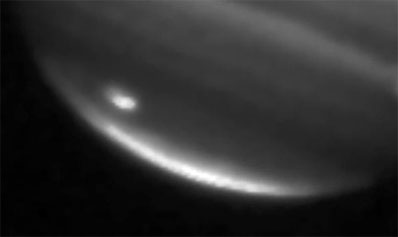 This image shows a large impact shown on the bottom left on Jupiter's south polar region captured on July 20, 2009, by NASA's Infrared Telescope Facility in Mauna Kea, Hawaii. Credit: NASA/JPL/Infrared Telescope Facility |
"We were extremely lucky to be seeing Jupiter at exactly the right time, the right hour, the right side of Jupiter to witness the event. We couldn't have planned it better," said Glenn Orton, a scientist at JPL.
Orton and his team of astronomers kicked into gear early in the morning and haven't stopped tracking the planet. They are downloading data now and are working to get additional observing time on this and other telescopes.
This image was taken at 1.65 microns, a wavelength sensitive to sunlight reflected from high in Jupiter's atmosphere, and it shows both the bright center of the scar (bottom left) and the debris to its northwest (upper left).
 This image shows a large impact shown on the bottom left on Jupiter's south polar region captured on July 20, 2009, by NASA's Infrared Telescope Facility in Mauna Kea, Hawaii. Credit: NASA/JPL/Infrared Telescope Facility |
Shoemaker-Levy 9 was a comet that had been seen to break into many pieces before the pieces hit Jupiter in 1994.
Leigh Fletcher, a NASA postdoctoral student at JPL who worked with Orton during these latest observations said, "Given the rarity of these events, it's extremely exciting to be involved in these observations. These are the most exciting observations I've seen in my five years of observing the outer planets!"
The observations were made possible in large measure by the extraordinary efforts of the Infrared Telescope Facility staff, including telescope operator William Golisch, who adroitly moved three instruments in and out of the field during the short time the scar was visible on the planet, providing the wide wavelength coverage.
JPL is managed for NASA by the California Institute of Technology in Pasadena.
Impact on Jupiter
The SOCIETY for POPULAR ASTRONOMY
***********************************
=====================================================
Special Electronic News Bulletin 2009 July 21
=====================================================
IMPACT ON JUPITER
Spaceweather.com
On July 19th, a veteran observer of Jupiter in Australia photographed
a fresh dark "scar" in Jupiter's cloudtops; the feature resembles the
Shoemaker-Levy 9 impacts of 1994. It is possible that Jupiter has
been struck anew by an asteroid or comet. Astrophotographers
around the world should train their optics on Jupiter to confirm the
event and monitor its progress. Visit http://spaceweather.com for
photos and updates.
Bulletin compiled by Clive Down
(c) 2009 the Society for Popular Astronomy

On the eve of the fortieth anniversary of Apollo 11, humanity's first landing on the moon, Apollo 11 crew members, Buzz Aldrin, left, Michael Collins, second from left, Neil Armstrong and NASA Mission Control creator and former NASA Johnson Space Center director Chris Kraft, right, gathered at the National Air and Space Museum in Washington, Sunday, July 19, 2009. The four were speakers at the Museum's 2009 John H. Glenn lecture in space history.
New NASA Images Indicate Object Hits Jupiter

 IMAGE ADVISORY: 2009-112 July 20, 2009
IMAGE ADVISORY: 2009-112 July 20, 2009New NASA Images Indicate Object Hits Jupiter
Scientists have found evidence that another object has bombarded Jupiter, exactly 15 years after
the first impacts by the comet Shoemaker-Levy 9.
Following up on a tip by an amateur astronomer that a new dark "scar" had suddenly appeared
on Jupiter, this morning between 3 and 9 a.m. PDT (6 a.m. and noon EDT) scientists at NASA's
Jet Propulsion Laboratory in Pasadena, Calif., using NASA's Infrared Telescope Facility at the
summit of Mauna Kea, Hawaii, gathered evidence indicating an impact.
New infrared images show the likely impact point was near the south polar region, with a visibly
dark "scar" and bright upwelling particles in the upper atmosphere detected in near-infrared
wavelengths, and a warming of the upper troposphere with possible extra emission from
ammonia gas detected at mid-infrared wavelengths.
"We were extremely lucky to be seeing Jupiter at exactly the right time, the right hour, the right
side of Jupiter to witness the event. We couldn't have planned it better," said Glenn Orton, a
scientist at JPL.
The new Jupiter images are online at: http://www.jpl.nasa.gov/news/news.cfm?release=2009-112 .
Orton and his team of astronomers kicked into gear early in the morning and haven't stopped
tracking the planet. They are downloading data now and are working to get additional observing
time on this and other telescopes.
This image was taken at 1.65 microns, a wavelength sensitive to sunlight reflected from high in
Jupiter's atmosphere, and it shows both the bright center of the scar (bottom left) and the debris
to its northwest (upper left).
"It could be the impact of a comet, but we don't know for sure yet," said Orton. "It's been a
whirlwind of a day, and this on the anniversary of the Shoemaker-Levy 9 and Apollo
anniversaries is amazing."
Shoemaker-Levy 9 was a comet that had been seen to break into many pieces before the pieces
hit Jupiter in 1994.
Leigh Fletcher, a NASA postdoctoral student at JPL who worked with Orton during these latest
observations said, "Given the rarity of these events, it's extremely exciting to be involved in
these observations. These are the most exciting observations I've seen in my five years of
observing the outer planets!"
The observations were made possible in large measure by the extraordinary efforts of the
Infrared Telescope Facility staff, including telescope operator William Golisch, who adroitly
moved three instruments in and out of the field during the short time the scar was visible on the
planet, providing the wide wavelength coverage.
JPL is managed for NASA by the California Institute of Technology in Pasadena.
-end-






